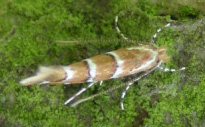Context
The discovery of this new insect pest, the horse chestnut leaf miner, Cameraria ohridella D.&D. (Lepidoptera Gracillariidae), in Macedonia in 1985 was followed by its rapid spread through Eastern and Central Europe and subsequent invasion of all parts of Western Europe. First detected in Belgium in 1998, the insect travelled west to reach the ornamental nurseries of Wallonia in 2002, where the young chestnut trees provided ideal conditions for its further spread. This pest’s main host is the horse chestnut tree (Aesculus hippocastanum), but it is also observed on other Aesculus species, notably A. parviflora, A. pavia and A. glabra, the hybrid A. x carnea being more resistant. Only the larval stage of this pest is phytophagous, causing leaf damage due to the characteristic mine formed. By the third annual generation of the insect the mines may be so numerous as to cover almost the whole of the laminae, not only marring the appearance of the leaves but above all impairing their capacity for photosynthesis and thus causing premature leaf abscission. Total defoliation may then occur, further detracting from the appearance of ornamental trees. In fast-growing young nursery plants, early destruction of the foliage is a major source of stress, leading to weakening and even death of the young trees. The adult stage of the pest is a little harmless moth with a strong capacity of colonisation which enables it to spread rapidly throughout Europe. Three flight periods occur in our climatic conditions. Adults emerging from the mines and the young larvae before penetrating the leaf offer a potential target for appropriate phytosanitary treatment on three occasions in a single growing season.Objectives
The aim of the project is to determine the species’ three flight periods in western nurseries in order to synchronise insect pest emergence as closely as possible with the phytosanitary control recommended to growers. Mass trapping as a means of reducing pesticide input is a further aspect.Description of tasks
To pinpoint the leaf miner’s emergence period, trapping by means of synthetic pheromones not then commercially available (Dr. A. Svatos, Czech Republic) began in 2003 in nurseries at Lesdain, in cooperation with CEHW, for the purpose of determining the insect’s flight curves and alerting nurserymen to the most favourable times for treatment. The specific pheromone has been on the market since 2004 (Biobest) and is thus now available to all growers. Consequently, mass trapping at nurseries, where the number of each plant species planted is often no more than a few rows, can be envisaged.Expected results
Continuing trapping campaigns at nurseries should enable our existing knowledge of horse chestnut leaf miner flight in this country to be developed and above all should contribute to more effective phytosanitary management at nurseries for quality plant production. Demonstrating the feasibility of mass trapping as a control method in these confined growing conditions would enable the repeated application of insecticides to be perceptibly reduced in the environment.Contribution
Discovering the presence of the horse chestnut leaf miner in nurseries in the west of the country. Initial monitoring of leaf miner flight at nurseries with the aid of pheromone traps. Establishing leaf miner phenology in the prevailing climatic conditions (Western and Central Belgium). Control warnings, synchronised with leaf miner emergence, to nurserymen in Wallonia at each critical period.Partners
- Walloon Regional Horticultural Testing Centre (CEHW)
- ULB (Animal and Cell Biology Laboratory)
Funding
- CRA-W - Walloon Agricultural Research Centre
- SPW - DG Economy and Employment
